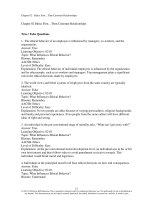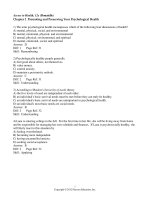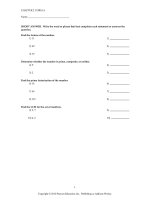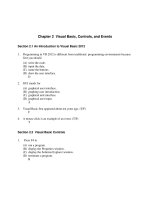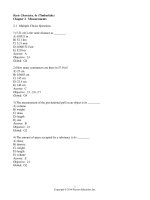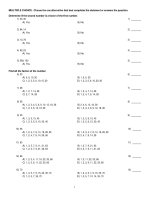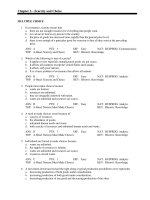Criminal investigation basic perspectives 12th edition lushbaugh test bank
Bạn đang xem bản rút gọn của tài liệu. Xem và tải ngay bản đầy đủ của tài liệu tại đây (396.61 KB, 28 trang )
Online Instructor’s Manual
with Test Bank
Criminal Investigation
Basic Perspectives
Twelfth Edition
Charles A. Lushbaugh
Paul B. Weston
Upper Saddle River, New Jersey
Columbus, Ohio
1
______________________________________________________________________________________
Copyright © 2012 by Pearson Education, Inc., Upper Saddle River, New Jersey 07458. Pearson
Prentice Hall. All rights reserved. Printed in the United States of America. This publication is protected by
Copyright and permission should be obtained from the publisher prior to any prohibited reproduction,
storage in a retrieval system, or transmission in any form or by any means, electronic, mechanical,
photocopying, recording, or likewise. For information regarding permission(s), write to: Rights and
Permissions Department.
Pearson Prentice Hall™ is a trademark of Pearson Education, Inc.
Pearson® is a registered trademark of Pearson plc
Prentice Hall® is a registered trademark of Pearson Education, Inc.
Pearson Education Ltd., London
Pearson Education Singapore Pte. Ltd.
Pearson Education Canada, Inc.
Pearson Education—Japan
Pearson Education Australia Pty. Limited
Pearson Education North Asia Ltd. , Hong Kong
Pearson Educación de Mexico, S.A. de C.V.
Pearson Education Malaysia Pte. Ltd.
10
ISBN-13: 978-0-13-511052-2
ISBN-10:
0-13-511052-1
2
CONTENTS
Preface
iv
Chapter 1
Evolution of Policing and Investigation
1
Chapter 2
Rules of Evidence and Arrest
6
Chapter 3
The Crime Scene
13
Chapter 4
Circumstantial Evidence
19
Chapter 5
Laboratory and Technical Services
22
Chapter 6
Basic Investigative Leads and Informants
26
Chapter 7
Interviewing and Interrogation
31
Chapter 8
Crimes of Violence
38
Chapter 9
Sexual Assaults
43
Chapter 10
Robbery
47
Chapter 11
Arson, Bombing, and Hate Crimes
51
Chapter 12
Property Crimes
55
Chapter 13
Dangerous Drugs
59
Chapter 14
Special Investigations
64
Chapter 15
Terrorism
69
Chapter 16
The Investigator as a Witness and Ethical Awareness
75
Syllabus and Semester Paper
79
Test Bank
82
Answer Key to Test Questions
163
iii
Preface
This manual was written to assist instructors using the 12th edition of Criminal
Investigation: Basic Perspectives. Each chapter in the text has a corresponding
chapter in this manual. The chapters in this manual are organized with an
introductory statement of chapter content, followed by a lecture outline for the
chapter. A number of discussion or essay questions are provided for in-class
discussion or for test questions. Thirty test items are included at the end of each
chapter. These test questions are in the multiple choice, true/false and fill-in
format.
The sample syllabus provided will give students basic information about course
content, presentation, objectives, and requirements. The suggested semester paper
outlines the organization of the paper required of students and offers a selected
bibliography of contemporary true-crime books as a resource guide for students.
iv
CHAPTER 1
EVOLUTION OF POLICING AND INVESTIGATION
Chapter Outline
Early Response to Crime
Night Watch
Thief-Takers
Bow Street Runners
London’s Metropolitan Police
American Policing
The Reform Movement
Development of Forensic Science
Local Policing
State Policing
Federal Investigative Agencies
Learning Objectives
After reading this chapter the student will be able to:
Discuss the evolution of policing in England and how this history applies to American
policing.
Evaluate the differences between the early English and American models of policing.
Describe the emergence of the Reform Movement in American policing and the major
tenants of the reform agenda.
Discuss the historical development of the major events that have led to the field of forensic
science and the persons responsible for these breakthroughs.
Identify the various policing agencies at the local, state, and federal levels and their areas of
responsibility.
Introduction
Modern policing is a relatively new concept. Prior to the introduction of policing, people were
responsible for their own protection. The first policing efforts were rudimentary and evolved
over time to a professional policing model. In the United States, the move towards professional
policing was aided by the scientific community. Modern criminal investigations are conducted at
the local, state, and federal level by a variety of law enforcement agencies.
5
Lecture Outline
A. Early Response to Crime
1. English law was used to form the basis of our own modern legal system.
2. The first U.S. police agencies were modeled after the London Metropolitan police.
3. Night Watch- In England in 1285, the Statute of Winchester required all towns to have
men on the streets after dark to provide for the safety of travelers and the town’s
inhabitants. The watchmen were supervised by a constable. The statute required citizens
to come to the aid of the night watchmen whenever they gave the hue and cry for
assistance. Eventually, night watchmen became paid employees in order to improve the
quality of the service.
B. Thief-takers
1. In 1689, the English government established rewards for the conviction of crimes.
Thief-takers often got involved as a sort of bounty hunter to acquire the reward money
and the confiscate the criminal’s possessions.
C. Bow Street Runners
1. In 1748, Henry Fielding organized a group of former constables and thief-takers to
carry out investigations and bring suspects to trial.
2. His brother John Fielding, considered to be the father of the modern police detective,
instituted several changes in the system by:
a. organizing mounted patrols to protect the highways and foot patrols on the city
streets
b. establishing the Police Gazette to encourage victims to report crimes to his
court
D. London’s Metropolitan Police
1. British Home Secretary Robert Peel
a. A strong advocate of establishing a police force to combat crime
b. Known today as the father of policing
2. The new police force was uniformed as to be readily identifiable to the citizenry.
3. Officers were issued a numbered badge so citizens could properly identify the officers.
4. The police were modeled along military organizational lines, which is still in use
today.
5. The police force included nearly 3,000 officers
6. Officers carried only nightsticks for protection, and were instructed to be respectful to
the public.
E. American Policing
1. In 1845 the New York City established a police force modeled after the London
Metropolitan Police. Major differences would cause problems:
a. London’s police were administered at the federal level; early American police
departments at the city level.
b. The corrupt “spoils system”
c. Patronage- an applicant had to have political friends to become an officer or
money to buy the job.
d. American police had no hiring standards; recruits received little or no training.
2. The emphasis of early policing was to maintain order. The police paid little attention to
the investigation or prevention of crime and often accepted payments to ignore vice.
6
F. The Reform Movement
1. August Vollmer—One of the chief advocates of police reform, chief of police in
Berkeley, California, from 1905 to 1932. Six-point agenda:
a. Policing should serve the community on a non-partisan basis
b. Politics should be eliminated from policing
c. Law enforcement agencies should have qualified chief executives
d. Better hiring and training standards for new recruits
e. Modern management principles; centralized command and control of police
operations
f. Specialized units such as traffic, juvenile, and vice
2. Civil service system
3. 1930s Great Depression helped move policing towards professionalism.
G. Development of Forensic Science
1. Forensics—the use of science to answer legal questions has developed over
time
from contributions from a variety of disciplines.
2. Mathieu Orfila (1787-1853) the father of forensic toxicology, the study of the effects
of poisons.
3. Hans Gross (1848-1915) an Austrian magistrate who was the earliest advocate of
criminal investigation as a science which he outlined in his book System der
Kriminalistik, (1906).
4. Alphonse Bertillon (1853-1914) developed the first means of human identification
known as anthropometry.
a. This system involved the taking of 11 measurements of various parts of the
human body. The system worked well for over two decades until unraveled by the
Will West case in 1903.
5. Francis Galton (1822-1911) provided the first definitive study of fingerprints which
led to the creation of a classification system.
6. Albert S. Osborn (1858-1946) authored the first significant text in the field of
questioned documents in 1910.
7. Edmond Locard (1877-1966) founder and director of the Institute of Criminalistics at
the University of Lyons. Best known for his exchange principle.
8. Leone Lattes (1887-1954) devised a procedure for determining blood group from
dried bloodstains and applied this technique to criminal investigations.
9. Calvin Goddard (1891-1955) refined the techniques for bullet comparison by using a
comparison microscope.
10. Alec Jeffreys (1950–) in 1985 conducted an investigation into the structure of the
human gene that led to the discovery of deoxyribonucleic acid (DNA) at Leicester
University, England.
H. Local Policing
1. Local policing provided by municipal, or city police departments, or by the county
sheriff’s department.
a. In the U.S.: over 12,600 police departments, and over 3,000 sheriff’s
departments. These agencies employ over 600,000 sworn officers, of which 73%
are employed by city police departments.
2. City police departments typically provide patrol, traffic, and detective functions.
7
a. Detective division—Handles crimes that require follow-up investigation;
searches for witnesses and suspects and evidence not located at the crime scene;
conducts specialized investigations.
b. Traffic division—Enforces vehicle code regulations and conducts accident
investigations; arrests motorists operating a vehicle while under the influence of
alcohol or drugs.
3. Sheriff’s departments—Provide law enforcement–related functions to areas located
outside city police department jurisdictions.
a. Other duties include the operation of the county jail, courthouse security, and
is the enforcement of court orders.
I. State Policing
1. Most states provide law enforcement services in three broad areas:
a. Patrol of the state’s highways
b. General law enforcement, including patrol and detective functions, to areas not
serviced by a municipal police department or sheriff
c. Specialized investigations
J. Federal Investigative Agencies
1. Every branch of the federal government has an investigative agency that is responsible
for the investigation of violations of the law that come within its jurisdiction. Highprofile federal agencies include:
a. Marshal’s service—Provide court security for the federal court system; serve as
bailiffs to the federal courts; guard prisoners while they are in court; transports
convicted prisoners to correctional facilities; enforce federal court orders.
b. Postal Inspection Service—Jurisdiction over mail frauds and mail theft, as well
as crimes that occur on postal property, including burglary, robbery, and
homicide; investigates the use of the mail to distribute child pornography.
c. Secret Service— Responsible for protecting the president, major presidential
candidates, the president-elect, the president’s immediate family, the vice
president, and former presidents; investigates financial offenses, federal-interest
computer fraud, fraudulent identification documents, and computer-based crimes.
Since 2003 the agency has been under the Department of Homeland Security.
d. Federal Bureau of Investigation—Jurisdiction over violations
of more than 200 categories of federal law. Responsible for counter-terrorism,
counterintelligence, cyber crime, as well as investigations involving public
corruption, civil rights, organized crime, white-collar crime, and major thefts.
e. Bureau of Alcohol, Tobacco, Firearms and Explosives— Responsible for
enforcing the law relating to alcohol, tobacco, firearms, and explosives, as well as
the investigation of commercial arson.
d. Drug Enforcement Administration—The DEA has concurrent jurisdiction with
the FBI domestically on controlling illegal drugs and has sole responsibility for
coordinating these investigations abroad.
Discussion/Essay Questions
1. Explain the problems associated with the use of thief-takers to solve crime.
8
2. Compare and contrast early American policing efforts with those of the London Metropolitan
Police.
3. Explain how of the agenda of the reform movement in American policing was implemented.
4. Compare and contrast municipal police departments and sheriff’s departments.
9
CHAPTER 2
RULES OF EVIDENCE AND ARREST
Chapter Outline
Search Warrants
Warrantless Searches
Consent Search
Stop and Frisk
Plain View Exception
Search Incident to a Lawful Arrest
Motor Vehicle Stop
Open Fields
Exigent Circumstances
Exclusionary Rule
Arrest vs. Detention
Arrest Warrants
Locating the Suspect
The Broadcast Alarm
Records as Sources of Information
Wanted Notices
The Arrest
Case Preparation
The Defendant’s Identity
The Defendant and the Corpus Delicti
Negative Evidence
Lawful Procedures
The Decision to Charge
Closing an Investigation
Learning Objectives
After reading this chapter the student will be able to:
Define the process for obtaining a search warrant and the information required in the warrant
application.
Recognize the various exceptions to the search warrant requirement.
Explain the situations that would place an investigator in a lawful position to view and seize
evidence according to the plain view exception.
Discuss the justification for the motor vehicle exception to the search warrant requirement.
Describe the action taken by the courts in dealing with evidence that does not meet the
standards established by the Fourth Amendment.
Appreciate the need for immediate action in the preparation of a broadcast alarm for wanted
persons who have just committed a crime.
Understand the progression from the broadcast alarm to the use of wanted notices in the
search for wanted persons.
10
Discuss the various public sources of information that are available to investigators in their
search for wanted persons.
Discuss the options available to an investigator to close an investigation without making an
arrest.
Introduction
No evidence is admissible in a court of law unless it is relevant; there must be a connection
between a fact offered in evidence and the issue to be proved. Evidence must also be material,
that is, capable of properly influencing the outcome of the trial. Third and most contentious is
that the evidence must also be lawfully obtained. The courts’ remedy for the handling of illegally
seized evidence is to exclude the evidence from trial.
Lecture outline
A. Search warrants—the Fourth Amendment to the United State Constitution provides
protections against unreasonable searches and seizures.
1. The issuance of a warrant makes a search reasonable due to the placing of an unbiased
third party, a judge, into the process.
2. The role of the judge is to review the application for a search warrant and determine if
the request is reasonable and meets the guidelines established by the 4th amendment.
3. To obtain a search warrant an investigator must prepare a written application which
outlines the probable cause for the search and describes the place to be searched and the
person or things to be seized.
a. As used in the warrant requirement probable cause exists when there are
enough facts to lead a reasonable prudent person to believe that there is a fair
probability of criminal activity.
b. Description of the place to be searched means that the investigator must
provide sufficient detail in the warrant application to identify the location of the
requested search.
c. Description of the persons or things to be seized means the investigator must
outline exactly what they are searching for.
d. The application for a search warrant must be supported by Oath or affirmation.
4. In emergency situations an investigator can obtain a search warrant by telephone.
5. Search warrants must be executed within a prescribed period of time, normally within
10 days.
B. Warrantless searches—the U.S. Supreme Court has defined as reasonable a number of
searches conducted without a warrant.
1. Consent searches—a person can voluntarily consent to a search of their person, home,
and property.
a. Consent to search property can only be given by the actual owner or by a
person in charge of that property.
b. A person has an absolute right to refuse to consent to a search.
c. A consent search is unreasonable if the consent was obtained by deceit,
trickery, or misrepresentation.
11
2. Stop and frisk—a peace office may temporarily detain a person for questioning and
pat-down that person for weapons if the officer has a reasonable suspicion that criminal
activity may be involved and that the pat down was necessary for officer safety reasons.
a. Reasonable suspicion for a detention must be based on facts that can be
articulated in court.
b. The detention must be fairly short in duration and only long enough to clarify
the reasons for the detention.
c. Any evidence discovered during this detention would be admissible in court.
3. Plain-view exception—Investigators may seize evidence without a warrant if the
officer is lawfully in a position to view an object and if the incriminating character of the
object is immediately apparent.
a. Effecting an arrest—Objects that come into view during a lawful arrest may be
seized.
b. Executing a search warrant—Items of evidence lying in plain view even though
not describe in the warrant may be seized.
c. Pursuing a fleeing suspect—Items seen while in hot pursuit may be seized.
d. Responding to an emergency—Officers dealing with emergency situations may
seize items of evidence in plain view.
4. Search incident to a lawful arrest—A police officer has the authority to conduct a
search incident to a lawful arrest.
a. The scope of the search includes the person of the arrestee and their
possessions.
b. Also included is the area which the arrestee could reach to retrieve a weapon or
destroy evidence.
c. Adjoining areas may be searched for persons posing a threat to the officers or
the arrest scene.
d. The search must be made contemporaneous with the arrest.
5. Motor-vehicle stop—An exception to the warrant requirement due to their mobility
and their use as transportation to and from crime scenes.
a. Probable cause must exist to believe the vehicle contains evidence of crime or
contraband.
b. Locked containers may also be searched provided probable cause exists relating
to these locked containers.
c. Impound procedures—Not a search but an administrative custodial procedure.
Contraband or items of evidence may be seized if observed during the inventory
process.
6. Open fields—Such as unoccupied or undeveloped areas are not protected by the 4th
Amendment
a. Only homes, person, effects and papers are protected.
b. “Open fields” includes open lands and forests.
c. Exception would be the area immediately surrounding a dwelling.
7. Emergency circumstances—When probable cause exists that evidence is likely to be at
a certain place an entry may be made if exigent circumstances exist.
a. A reasonable belief that the evidence may be immediately destroyed.
b. Hot pursuit of a suspect whom the officers believe is in the area.
c. Where there is an immediate need to protect or preserve life.
12
d. A threat to officer safety exists requiring a protective sweep of the area.
C. Exclusionary rule—Prevents illegally obtained evidence from being admitted into evidence
during the trial.
1. “Fruit of the poisonous tree doctrine” holds that evidence which is derived from an
illegal search is inadmissible because of its original taint.
D. Arrest vs. Detention—Typically police encounters with the public fall within three categories.
1. The voluntary or consensual stop—Limited in scope by the consent given by the
person being encountered; that person can terminate the encounter at any time.
2. Investigative detention or stop and frisk encounter—The investigator must have
specific facts supporting a reasonable suspicion that criminal activity is occurring or
about to occur or has recently occurred.
a. Limited in time and scope to what is necessary to confirm or refute the
suspicion that criminal activity is occurring or about to occur.
b. The suspect is not free to leave and reasonable force may be used to detain the
person.
3. Arrest—A legal arrest must be based upon probable cause which is that point in time
when an investigator has reason to believe that a crime was or is about to be committed
and that the individual to be arrested has engaged in the criminal activity.
E. Arrest Warrants—Necessary when a person to be arrested is unavailable or his or her identity
is not known at the time. The following are the guidelines for the application of an arrest
warrant.
1. The warrant must describe the offense charged and contain the name of the accused, or
if the name is unknown, a description of the accused.
2. The warrant must also indicate the time of issuance, the city or county and state where
it is issued, and the duty of the arresting officer to bring the defendant before the
magistrate.
3. It is directed to, and thus may be acted on, by any peace officer in the jurisdiction. A
warrant issued in a state court is enforceable by any peace officer in that state.
4. Arrest warrants, unlike search warrants, are valid until they are recalled by the court.
5. The arrest warrant can specify the amount of bail needed by the accused to be released
from custody.
F. Locating the Suspect— The accused person may easily located or the suspect’s name may not
be known, and he or she may have no known address or may be in hiding or in flight.
G. The Broadcast Alarm-- Transmission of broadcast alarms usually is done first by radio and
then by, fax, or computer.
1. Accuracy is key.
2. When more than one perpetrator is described, a listing by number is recommended.
The following characteristics, in the order listed, are standard for these notices: race, sex,
adult or juvenile, age, height, weight, build, hair color, eye color, distinguishing
characteristics. A suspect’s height and weight are usually reported in blocks or ranges:
upward from 5 feet in 3-inch intervals, and from 100 pounds in 20-pound intervals.
3. Clothing is an observable characteristic that affords excellent opportunities for
recognizing a wanted person.
4. Vehicle descriptions in these alarms or pickup orders generally are limited to the
following: year, make, model, color, state license number, damage or suspected damage,
number and sex of occupants.
13
5. Direction of flight is included.
6. An all points bulletin (APB) is justified when adequate descriptive information is
available.
H. Records as Sources of Information—Among the sources of information are:
a. City and county. Vital statistics; tax, welfare, courts, schools, jurors, and voting
records; prosecutor and public defender.
b. State. Tax and corporate records; courts and alcohol beverage records; consumer
affairs data; motor vehicle license and registration files.
c. Federal. Federal Bureau of Investigation, and other federal law enforcement agencies
such as the Secret Service, Immigration and Customs Enforcement, Postal Inspection
Service, Securities and Exchange Commission, and military investigative agencies.
d. Private
I. Wanted Notices—Should provide full information about the fugitive and about areas in which
he or she is likely to be found.
1. The standard base of details for describing wanted persons is race, sex, age, height,
weight, color of eyes, and color of hair.
2. Fugitive occupation, associates, friends, relatives, habits, and hobbies are often
significant
factors.
3. A final segment of the description of a fugitive concerns whether he or she may resist
arrest.
4. The four purposes of a modern wanted notice for a fugitive from criminal
justice are:
a. To provide sufficient identifying characteristics (constituting reasonable
grounds for belief) to allow other law enforcement agents to provisionally identify
the fugitive upon initial contact and to make positive identification when the
suspect is taken into custody
b. To alert other law enforcement officers to the nature and character of the
fugitive, his or her criminal history, and if armed and dangerous
c. To suggest activities and areas in which a search or surveillance may locate the
fugitive
d. To delineate the crime in sufficient detail to alert arresting officers to potential
legally significant evidence available at the time of arrest.
J. The Arrest—Investigators assemble evidence to establish probable cause before they attempt
to arrest a suspect in a case.
1. All arresting officers should be alert to the nature and type of evidence that might
normally be encountered at the time of arrest.
2. The search incidental to an arrest may not only recover the proceeds of a theft but may
also produce transfer evidence that will link the suspect with the crime, the scene, or the
victim.
3. The doctrine of immediate control indicates the area in which a search is justified.
4. When a perpetrator is arrested locally, the search incidental to the arrest may involve
the home of the prisoner if it is the place of arrest.
5. An investigator may ask the arrested person to consent to a search of an office or
residence.
K. Case Preparation—The orderly array of information collected during an investigation:
14
all the reports, documents, and exhibits in a case. The investigator:
a. Collates the work of the entire investigation
b. Confers with associates
c. Prepares the case folder and its synopsis
d. Forwards the case to the prosecutor for preparation of the formal accusatory pleading
and the legal development of the case before trial
e. Marks the case closed by arrest
1. The Defendant’s Identity—Identification usually results from some combination of
testimony and other evidence.
2. The Defendant and the Corpus Delicti—The accusatory pleading must show that at a
specified time and date in a specific place, the named person committed an act or
omission in violation of a particular law specified by both name and section number and
in force at the time of the act or omission.
3. Negative Evidence—The second major area of case preparation concerns negative
evidence and is oriented to countering defenses to the crime charged.
4. Lawful Procedures— In most cases, such evidence will show one or more of the
following:
a. Nothing suggestive or otherwise improper in locating and interviewing
witnesses
b. The reasonableness of the search and the integrity of collecting and preserving
evidence
c. A reasonable surveillance that meets the requirements of due process
d. The voluntariness of a confession or admission, together with other due process
requirements
L. The Decision to Charge—The assigned prosecutor makes his or her decision and moves
through the stages necessary for trial or recommends that no action be taken at this time and
details reasons for not taking action. The decision to charge is not a function or responsibility of
the investigator.
L. Closing an Investigation—An investigation is successful when the crime under investigation
is promptly solved and the case closed. The criminal investigation function can be terminated in
the following instances:
1. Results have been obtained in full; the case is cleared by arrest or exceptional
clearance.
2. Results have been obtained in part, and no further results can be obtained.
3. No results can be obtained.
Discussion/Essay Questions
1. Discuss the difference between probable cause and reasonable suspicion. How do these
concepts apply in criminal cases?
2. Describe the process for obtaining a search warrant and an arrest warrant.
3. Give two examples of situations that would justify a warrantless search.
4. Why is it useful to review a case from the point of view of the accused? Explain your
15
answer.
16
TEST BANK
17
Chapter 1 Test Questions
Multiple choice
1. U.S. police agencies were modeled after the: _____.
a. London Metropolitan police
b. posse comitatus
c. Bow Street Runners
d. None of these.
Page number: 3
Level: Intermediate
2. In 1285, this law required all English towns to have men on the streets after dark to provide
for the safety of travelers and the town’s inhabitants.
a. Magna Carta
b. Statute of Winchester
c. Statute of London
d. Statute of Northumberland
Page number: 3
Level: Easy
3. This Bow Street Runners leader instituted organized mounted patrols on the highways and
foot patrols on the city streets.
a. Henry Fielding
b. Robert Peel
c. August Vollmer
d. John Fielding
Page number: 4
Level: Difficult
4. This English politician is known as the “father of policing.”
a. John Fielding
b. Henry Fielding
c. Robert Peel
d. Alphonse Bertillon
Page number: 4
Level: Easy
5. Corrupt political machines operating under this system allowed politicians to extort money
from people and companies wanting to do business with the city.
a. spoils system
b. machine system
c. democratic system
d. patronage system
Page number: 7
Level: Intermediate
18
6. This American reformer advocated that the elimination of politics from policing.
a. August Vollmer
b. J. Edgar Hoover
c. Alphonse Bertillon
d. Albert S. Osborn
Page number: 7
Level: Difficult
7. This is the application of scientific techniques in collecting and analyzing physical
evidence.
a. forensics
b. the scientific method
c. criminalistics
d. the exchange principle
Page number: 9
Level: Easy
8. This is the use of science to answer legal questions.
a. criminalistics
b. forensics
c. toxicology
d. law
Page number: 9
Level: Difficult
9. The idea that when a criminal comes in contact with another object or person, a cross-transfer
of evidence occurs, primarily of hairs and fibers.
a. anthropometry
b. cross-contamination
c. the exchange principle
d. the Locard principle
Page number: 9
Level: Intermediate
10. The man who developed the first means of human identification, known as anthropometry,
was: _____.
a. Mathieu Orfila
b. Hans Gross
c. Alphonse Bertillon
d. Francis Galton
Page number: 9
Level: Intermediate
19
True or false
1. The father of criminal identification, the person who developed the first means of human
identification, was Alphonse Bertillon.
Page number: 9
Level: Easy
2. Calvin Goddard expanded upon the discovery that blood can be grouped into four different
categories.
Page number: 9
Level: Intermediate
3. Policing at the local level is provided by municipal or city police departments outside the city
limits.
Page number: 10
Level: Difficult
4. Those crimes that require follow-up investigation are typically referred to a detective division.
Page number: 10
Level: Easy
5. Sheriff’s personnel may provide security for the courthouse and serve as bailiffs that guard
prisoners when they appear in court.
Page number: 11
Level: Difficult
6. Every branch of the federal government has an investigative agency that is responsible for the
investigation of violations of the law that come within its jurisdiction.
Page number: 11
Level: Intermediate
7. In 1981, Congress gave the Secret Service the responsibility of protecting the president
following the attempted assassination of President Reagan.
Page number:
Level: Easy
8. Since 2003, the FBI has been under the Department of Homeland Security.
Page number: 12
Level: Intermediate
9. In 1924, J. Edgar Hoover became the director of the FBI and remained in this position until his
death in 1972.
Page number: 12
Level: Easy
20
10. The DEA has concurrent jurisdiction with the FBI domestically on controlling illegal drugs
and has sole responsibility for coordinating these investigations abroad.
Page number: 12
Level: Intermediate
Fill-in
1. In early England, the _____ were supervised by a constable, also a private citizen, who served
a voluntary one-year term in this position as part of his civic duty.
Page number: 4
Level: Intermediate
2. In 18th-century England, _____, often criminals themselves, were motivated by reward money
and their ability to confiscate the possessions of the criminal.
Page number: 4
Level: Difficult
3. _____ is considered to be the father of the modern police detective.
Page number: 4
Level: Difficult
4. _____ was a term for the English police used in reference to Robert Peel and was a term of
respect and appreciation.
Page number: 6
Level: Intermediate
5. According to August Vollmer, policing should be a profession that serves the _____ on a nonpartisan basis.
Page number: 7
Level: Difficult
6. The _____ was created in 1789 with the passage of the first judiciary act and claims to be the
oldest federal law enforcement agency.
Page number: 11
Level: Intermediate
7. The _____ can trace its roots back to 1830 with the creation of the Office of Instructions and
Mail Depredations.
Page number: 11
Level: Intermediate
21
8. The first major expansion of the FBI came in 1910 when the agency became responsible for
the enforcement of the_____, which prohibited the transportation of women over state line for
immoral purposes.
Page number: 12
Level: Intermediate
9. In 1982 Congress passed the Anti-Arson Act declaring that arson is a federal crime and gave
the _____ the responsibility for investigation of commercial arson nationwide.
Page number: 12
Level: Difficult
10. The _____ was created by President Nixon through an executive order that merged several
agencies into a single unified command to combat the global war on drugs.
Page number: 13
Level: Difficult
22
Chapter 2 Test Questions
Multiple choice
1. _____ exists when enough facts lead a reasonable and prudent person to believe that a fair
probability of criminal activity exists.
a. Reasonable suspicion
b. Probable cause
c. Exigent circumstances
d. Contingent cause
Page number: 20
Level: Easy
2. Which constitutional amendment provides the citizens of the United States protections against
unreasonable searches and seizures?
a. First Amendment
b. Second Amendment
c. Third Amendment
d. Fourth Amendment
Page number: 18
Level: Intermediate
3. A person can waive constitutionally provided protections against unreasonable searches and
seizures and allow an investigator to search home, person, and property. Such a search is known
as: _____.
a. consent search
b. plain view search
c. stop and frisk
d. search incident to an arrest
Page number: 20
Level: Intermediate
4. The U.S. Supreme Court has held that a police officer may temporarily detain a person for
questioning if the officer has reasonable suspicion that criminal activity may be involved. The
person may also be patted down for weapons. This police action is known as: _____.
a. consent search
b. plain view search
c. stop and frisk
d. search incident to an arrest
Page number: 20
Level: Easy
23
5. This doctrine permits investigators to observe and seize evidence without a warrant if the
officer is lawfully in a position from which an object and the incriminating character of the
object are immediately apparent. This exception to the search warrant requirement is known as:
_____.
a. consent search
b. plain view search
c. stop and frisk
d. search incident to an arrest
Page number: 20
Level: Intermediate
6. Investigators who have established probable cause that evidence is likely to be at a certain
place may make a warrantless entry into the premises if what type of conditions exist?
a. exclusionary
b. inclusionary
c. exigent
d. conclusively
Page number: 24
Level: Easy
7. The method the courts use to uphold the constitutional protections against unreasonable
searches and seizures, as well as to control the investigator’s actions and prevent illegally
obtained evidence from being used at trial, is known as the: _____.
a. exclusionary rule
b. inclusionary rule
c. emergency rule
d. conclusively rule
Page number: 24
Level: Intermediate
8. In the interest of public safety, vehicles are frequently taken into police custody, such as when
reported stolen or when used in the commission of a crime. These vehicles may be examined,
inside and out, and any evidence of a crime may be lawfully seized under which theory of law?
a. search incident to arrest
b. motor vehicle exception
c. procedural search
d. inventory procedure
Page number: 22
Level: Easy
24
9. When a wanted fugitive is apprehended in another state, the fugitive has a right to a legal
hearing in which the prosecution must demonstrate the probable cause for the return of the
fugitive to the state where the crime occurred. These proceedings are known as:
a. extraditions
b. extrajudicials
c. extrajurisdictionals
d. exculpatory
Page number: 30
Level: Easy
10. The decision to charge a suspect with a crime is the duty of which person in the criminal
justice system?
a. judge
b. investigator
c. prosecutor
d. defense counsel
Page number: 33
Level: Easy
True or False
1. The Fifth Amendment to the U.S. Constitution protects against unreasonable search and
seizure.
Page number: 18
Level: Easy
2. In emergency situations an investigator can obtain a search warrant by telephone.
Page number: 19
Level: Intermediate
3. Search warrants must be executed within a prescribed period of time, usually within 10 days.
Page number: 19
Level: Easy
4. The restrictions regarding unreasonable search and seizure apply to private persons as well as
the police.
Page number: 19
Level: Intermediate
5. A person has an absolute right to refuse to consent to a search by the police and can revoke
consent at any time.
Page number: 20
Level: Intermediate
6. An investigator must have probable cause to conduct a stop-and-frisk detention and search.
Page number: 20
25
